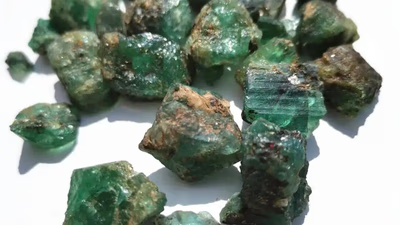
Emerald mines in Colombia and Zambia showcase unique gemstones.
Colombia is widely considered the most significant source of high-quality emeralds. The country's emerald deposits are concentrated in the eastern range of the Andes Mountains, with the Muzo, Coscuez, and Chivor mines being the most renowned. Colombian emeralds are highly prized for their deep green color, exceptional transparency, and often have a sought-after bluish-green hue. Zambia is another major producer of emeralds and has gained prominence in the global market. The Kagem mine, located in the Copperbelt region of Zambia, is one of the world's largest emerald mines. Zambian emeralds are known for their vivid green color, often with a slightly yellowish or bluish undertone. They are valued for their transparency and relatively large crystal sizes.
Zimbabwe is known for its emerald deposits, with the Sandawana mine being the most notable source. Zimbabwean emeralds are typically light to medium green and often exhibit a yellowish or bluish tint. They are valued for their transparency and can display exceptional clarity. Emerald crystals from Brazilian mines Colombian quality emerald, which has significant amounts of iron, which increases the specific gravity and refractive index of light in this stone. Their guest mineral is in the form of a saw blade. The most important mines of Colombia are Shivore, Gashala Borbar, Casquez and Mozo. In all these mines there is no trace of host minerals that existed before the growth of emerald crystals.
Emerald crystals from Brazilian mines Colombian quality emerald: which has significant amounts of iron, which increases the specific gravity and refractive index of light in this stone. Their guest mineral is in the form of a saw blade. The most important mines of Colombia are Shivore, Gashala Borbar, Casquez and Mozo. In all these mines there is no trace of host minerals that existed before the growth of emerald crystals. Like other minerals in this gemstone, it is formed from molten materials in the ground under hi gh pressure and heat, which can be found in granites, pegmatites (magma residues), schists and deposits. Unlike sapphire or ruby, the importance of emerald extraction in secondary mines is low and often from primary deposits in grooves, veins and fissures and is done directly from the parent rock containing it.
Today the best types of gemstone are obtained from Colombia. Lower quality varieties with medium to light color tones are obtained from Brazilian mines. Austria, India, Australia, South Africa, Egypt, the United States, Norway and Pakistan also have emerald mines. Over the past few decades, the number of quality species in Zimbabwe, Zambia and Tanzania has also increased. Only the types that have the best quality are clean and flawless. Most of them have small joints and indentations from other minerals. In the north of Russia, most of them are matte or yellow, and their quality type is very rare. Afghanistan's five-lion emeralds with crystal size (many over 100 carats) and good transparency compete with the best varieties found in Colombia that have had no analogues in the last 400 years. Recently, sources of this stone have been observed in Ethiopia. In the following, we will get more acquainted with these mines and explain them.
Brazil has a long history of emerald mining, particularly in the states of Minas Gerais, Bahia, and Goiás. The Belmont mine in the state of Minas Gerais is one of the most significant emerald mines in Brazil. Brazilian emeralds vary in color, ranging from light to medium green, and often exhibit good transparency. They are appreciated for their individuality and unique characteristics. Afghanistan has emerged as an important source of high-quality emeralds in recent years. The Panjshir Valley, located in the Hindu Kush Mountains, is known for producing emeralds with a distinctive bluish-green color and excellent transparency. Afghan emeralds have gained recognition for their intense color saturation and are highly valued in the gem market.
-

Emeralds, a rare variety of beryl, are distinguished by their vibrant green color, attributed to chromium and vanadium. Their scarcity is due to the unique geological conditions required for their formation. The value of emeralds is primarily determined by color, clarity, size, and origin. Colombian emeralds are renowned for their deep green hue and clarity, while Afghan emeralds are noted for their exceptional transparency. Inclusions known as jardin add character to emeralds but can affect their value. The market for these gemstones is competitive, with high-quality stones fetching astronomical prices at auctions. Notable historical emeralds include the Mogul Emerald and the Duke of Devonshire Emerald. Despite being softer than diamonds, emeralds rank 7.
5 to 8 on the Mohs scale, making them suitable for everyday wear with proper care. Treatments such as oiling are common to enhance clarity but can impact value if not disclosed. Larger emeralds are particularly sought after due to their rarity and beauty, often cut in styles that highlight their rich color. Throughout history, emeralds have symbolized wealth and power across various cultures.
-

Emerald and green beryl are both varieties of beryl, but they differ significantly in value and characteristics. Emerald is prized for its rich green hues, which are influenced by trace elements like chromium and vanadium. It is highly sought after, especially when it exhibits intense color, clarity, and larger carat weights. The rarity and historical significance of emeralds contribute to their high market prices. In contrast, green beryl is a broader term for green beryl gemstones that do not meet the specific criteria for emeralds. Typically lighter in color, green beryl lacks the prestige associated with emeralds and is considered a more affordable option for those who appreciate green gemstones without the investment value of emeralds. The extraction process of emeralds often results in fractures, leading to a common practice of oiling to enhance their appearance. Approximately 90% of emeralds on the market are treated with oil to fill surface-breaking fractures.
While both stones share visual similarities, emeralds are graded based on strict standards including color, clarity, carat weight, and cut quality. Green beryl does not have such rigorous grading or market demand but remains popular due to its affordability.
-

Gem dealers play a vital role in ensuring the authenticity of emeralds, distinguishing between natural and synthetic stones to maintain their reputation and uphold ethical standards. Natural emeralds are valuable investments, often characterized by unique inclusions and vibrant colors, while synthetic emeralds may appear too perfect or uniform. Dealers must possess expertise to assess gemstones accurately, as misrepresentation can lead to financial losses for both parties. Natural emeralds can vary in clarity and often undergo treatments to enhance appearance, which does not necessarily indicate they are synthetic. To ensure authenticity, gem dealers should seek the opinion of qualified gemologists or testing laboratories when in doubt. Staying informed about market trends and new imitation techniques is crucial for gem dealers to adapt and provide accurate information to customers. This knowledge fosters trust and long-term relationships with clients.
-

Colombia is the leading source of high-quality emeralds, with key mines like Muzo, Coscuez, and Chivor located in the Andes. Colombian emeralds are prized for their deep green color and exceptional clarity. Zambia"s Kagem mine is one of the largest globally, producing vivid green emeralds with notable transparency. Zimbabwe"s Sandawana mine yields lighter green stones that also exhibit clarity. Brazil has a rich history of emerald mining, particularly in Minas Gerais, where the Belmont mine is significant. Afghan emeralds from the Panjshir Valley are gaining recognition for their bluish-green hue and intense saturation. Other countries like Austria, India, and Ethiopia also contribute to the global emerald market. The quality of emeralds varies significantly across regions, with Colombia consistently producing the highest quality stones.




